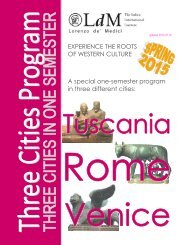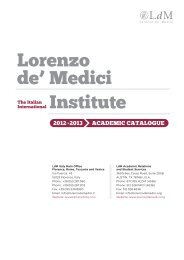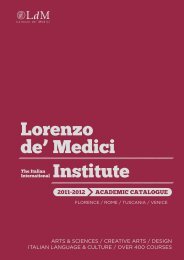aCademiC Catalog 2013-2014 - Lorenzo de Medici
aCademiC Catalog 2013-2014 - Lorenzo de Medici
aCademiC Catalog 2013-2014 - Lorenzo de Medici
Create successful ePaper yourself
Turn your PDF publications into a flip-book with our unique Google optimized e-Paper software.
inclu<strong>de</strong> but are not limited to: writing articles, updating articles,<br />
events research, filing database entries; contributing to blogs,<br />
social media, websites; <strong>de</strong>veloping new projects.<br />
Note: Placement opportunities are limited and subject<br />
to change. Stu<strong>de</strong>nts who enroll must submit supporting<br />
documentation by the registration <strong>de</strong>adline, and acceptance is<br />
conditional upon result of an onsite interview during the first<br />
week of the term. Fluency in Italian may be advantageous.<br />
Prerequisites: English/Writing/Journalism majors of junior<br />
standing<br />
Cultural Studies<br />
Food and Culture<br />
CLT 198 F; Dual listed: ANT 198 F / NUH 198 F<br />
Cr: 3; Contact hrs: 45<br />
If “you are what you eat”, just why do you eat the way you do?<br />
This course consi<strong>de</strong>rs the relationships between the multiple<br />
meanings of food and the acts of preparing and eating food,<br />
and further explores food and personal and social i<strong>de</strong>ntity.<br />
Stu<strong>de</strong>nts will examine why different people make different<br />
food choices in their daily lives, why individuals from certain<br />
social classes will avoid or esteem particular foods, and in<br />
general how food serves as a factor in self-<strong>de</strong>finition. Because<br />
a person’s attitu<strong>de</strong> toward food can reveal not just personal<br />
i<strong>de</strong>ntity traits but a whole food i<strong>de</strong>ology, this course will also<br />
analyze the role of food in the construction of ethnic i<strong>de</strong>ntity, in<br />
the display of religious beliefs, and in the negotiation of gen<strong>de</strong>r<br />
roles. Stu<strong>de</strong>nts learn how cultures and values are transmitted<br />
and preserved through food. Through personal essays and the<br />
interdisciplinary secondary literature, stu<strong>de</strong>nts will be gui<strong>de</strong>d<br />
to analyze the complex and fascinating relationships between<br />
people and food, helping them to un<strong>de</strong>rstand how cultures<br />
(including their own) ultimately <strong>de</strong>termine all human food<br />
choices.<br />
Women, History and Culture<br />
CLT 250 F; Dual listed: GND 250 F<br />
Cr: 3; Contact hrs: 45<br />
The course surveys the changing roles and perceptions of<br />
women in Western history and culture from ancient times to<br />
the present. The relatively recent political enfranchisement<br />
of women and the rise of feminist thought and theory offer<br />
a framework and a <strong>de</strong>stination. Stu<strong>de</strong>nts examine a wi<strong>de</strong><br />
variety of exemplary roles (wife, mother, priestess, nun, etc.)<br />
and individuals. Matrifocal societies and the wi<strong>de</strong>spread cult of<br />
the Mother God<strong>de</strong>ss were supplanted by patriarchal traditions,<br />
examined through Judaism and the Classical Greek world and<br />
their i<strong>de</strong>as, texts, mythologies, and social strategies. Stu<strong>de</strong>nts<br />
next explore the religious, social, and medical views of the first<br />
millenium and a half of the CE. With the Renaissance arrive<br />
new and better-documented perceptions by and of women.<br />
Social policies and both high and popular culture reveal<br />
persistent prejudices. The Early Mo<strong>de</strong>rn era brings changes<br />
in social position as women become agents in the arts and<br />
sciences. Women’s Rights are inscribed upon wi<strong>de</strong>r social and<br />
cultural struggles of the mo<strong>de</strong>rn world. In conclusion, stu<strong>de</strong>nts<br />
encounter constructions of women present in today’s culture<br />
and media, and still unresolved issues.<br />
Prerequisites: HIS 130 Western Civilization, or equivalent<br />
Many Italies, Other Italies: Mo<strong>de</strong>rn Literary<br />
Representations<br />
CLT 285 F; Dual listed: LIT 285 F<br />
Cr: 3; Contact hrs: 45<br />
Focusing on Italian and Anglo-American literature and some<br />
films, this course will explore the multiple representations of<br />
Italy in the twentieth and twenty-first Century. Far from being<br />
the homogeneous culture that is often perceived from abroad,<br />
Italian culture is a very complex text where many different, and<br />
sometimes conflicting voices and images encounter. This course<br />
aims to look beyond what may be seen as mainstream Italy<br />
to discover peoples often marginalized by dominant cultural<br />
norms and stereotypes. Starting with the critical examination<br />
of the i<strong>de</strong>alized image of Italy propagated by many famous<br />
foreigners throughout the ages, the course will then focus<br />
on the representation of Italy offered by its own writers and<br />
filmmakers. The texts that we will look into encompass many<br />
different peripheral voices that are nonetheless very powerful<br />
and fundamental to a true un<strong>de</strong>rstanding of the Italian culture:<br />
southern Italians, Jewish Italians, emigrants (and Italian<br />
Americans), political dissi<strong>de</strong>nts, women, and more recently,<br />
immigrants from the global East and South are the voices<br />
that have contributed to create a country of intrinsically great<br />
and complex ethnic, religious, linguistic and political diversity;<br />
voices that often remain unheard.<br />
Italian Culture through Music<br />
CLT 292 F; Dual listed: MCT 292 F<br />
Cr: 3; Contact hrs: 45<br />
This course offers stu<strong>de</strong>nts an approach to un<strong>de</strong>rstanding<br />
Italian culture and society through an exploration of its rich<br />
and varied musical traditions. Mountainous geography and<br />
political struggles have given Italy a wi<strong>de</strong> variety of musical<br />
styles and cultures. Taking the form of a musical journey across<br />
Italy, the course explores sacred, secular and dramatic music<br />
from the major Italian cities and also strays off the beaten<br />
path to discover the vibrant folk traditions of villages and rural<br />
communities. The course also explores the origins and influence<br />
of Italy’s dramatic and lyrical tradition, from the early multimedia<br />
spectacles of 16th-century Florence to the patriotic<br />
operas of Verdi and the realism of Puccini. Classes will inclu<strong>de</strong><br />
musical illustrations and <strong>de</strong>monstrations and stu<strong>de</strong>nts will also<br />
be encouraged to go to related concerts and musical events in<br />
Florence and Tuscany. Music offers an original and important<br />
perspective on the culture of Italy.<br />
Broadcasting: Italian Culture and Television<br />
CLT 305 F; Dual listed: COM 305 F / SOC 305 F<br />
Cr: 3; Contact hrs: 45<br />
This course examines the <strong>de</strong>velopment of commercial<br />
television broadcasting, its beginnings in radio and its creation<br />
of distinctive genres in Italy. Italian state and private television<br />
are analyzed and compared. The course also consi<strong>de</strong>rs<br />
different theoretical approaches to the analysis of television by<br />
investigating the various theories of its effects and the impact<br />
on other media. The course will examine today’s main trends,<br />
strategies and broadcast in Italian television. A strong link is<br />
also provi<strong>de</strong>d between Italian television and Italian culture.<br />
Prerequisites: COM 180 Mass Communication, or equivalent<br />
Images and Words<br />
CLT 355 F; Dual listed: ART 355 F<br />
Cr: 3; Contact hrs: 45<br />
In this interdisciplinary course different disciplines converge<br />
to enhance stu<strong>de</strong>nts’ skills as rea<strong>de</strong>rs of visual as well as<br />
verbal texts. It aims to open up new ways of seeing and<br />
perceiving works of art by exploring the relationship between<br />
us (spectators and/or creators), images and words, involving<br />
questions such as What is art? Where do we see art? How do<br />
we look at art? What words do we use while talking about a<br />
work of art, explaining and/or <strong>de</strong>scribing it? Can we “read”<br />
images? Can we “see” stories? Stu<strong>de</strong>nts analyze a selection of<br />
fundamental theoretical texts and produce close examinations<br />
of visual and written works, including narrative prose and poetry.<br />
Stu<strong>de</strong>nts have the opportunity to become active spectators<br />
who, through activities of observing, reading, sketching and<br />
writing, experience different mo<strong>de</strong>s of looking at art while<br />
learning about art theory, art history, literature, museum culture<br />
and sociology.<br />
Prerequisites: Junior standing<br />
Gen<strong>de</strong>r Studies<br />
Women, History and Culture<br />
GND 250 F; Dual listed: CLT 250 F<br />
Cr: 3; Contact hrs: 45<br />
The course surveys the changing roles and perceptions of<br />
women in Western history and culture from ancient times to<br />
the present. The relatively recent political enfranchisement<br />
of women and the rise of feminist thought and theory offer<br />
a framework and a <strong>de</strong>stination. Stu<strong>de</strong>nts examine a wi<strong>de</strong><br />
variety of exemplary roles (wife, mother, priestess, nun, etc.)<br />
and individuals. Matrifocal societies and the wi<strong>de</strong>spread cult of<br />
School of Arts & Sciences FLORENCE<br />
LdM Aca<strong>de</strong>mic <strong>Catalog</strong> <strong>2013</strong>-<strong>2014</strong><br />
61





